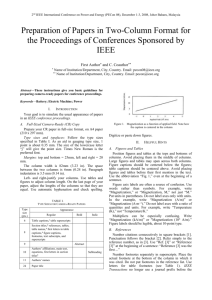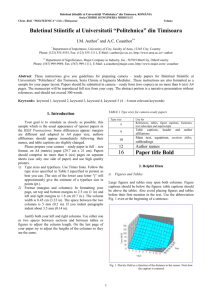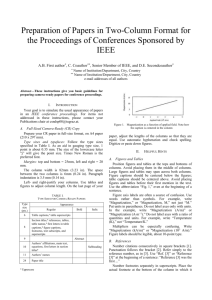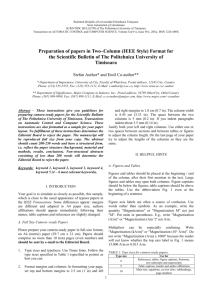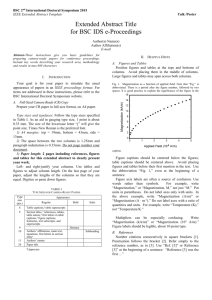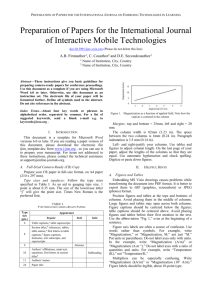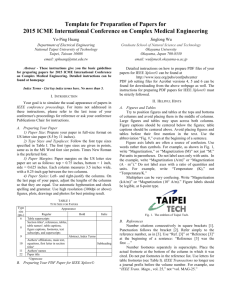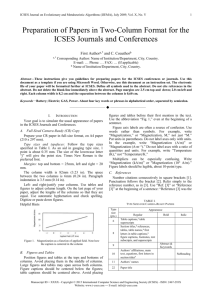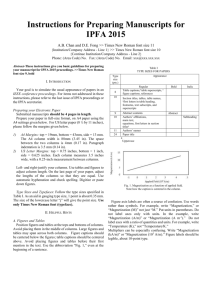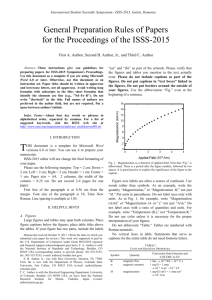instructions for authors - XII International Conference SAUM 2014
advertisement
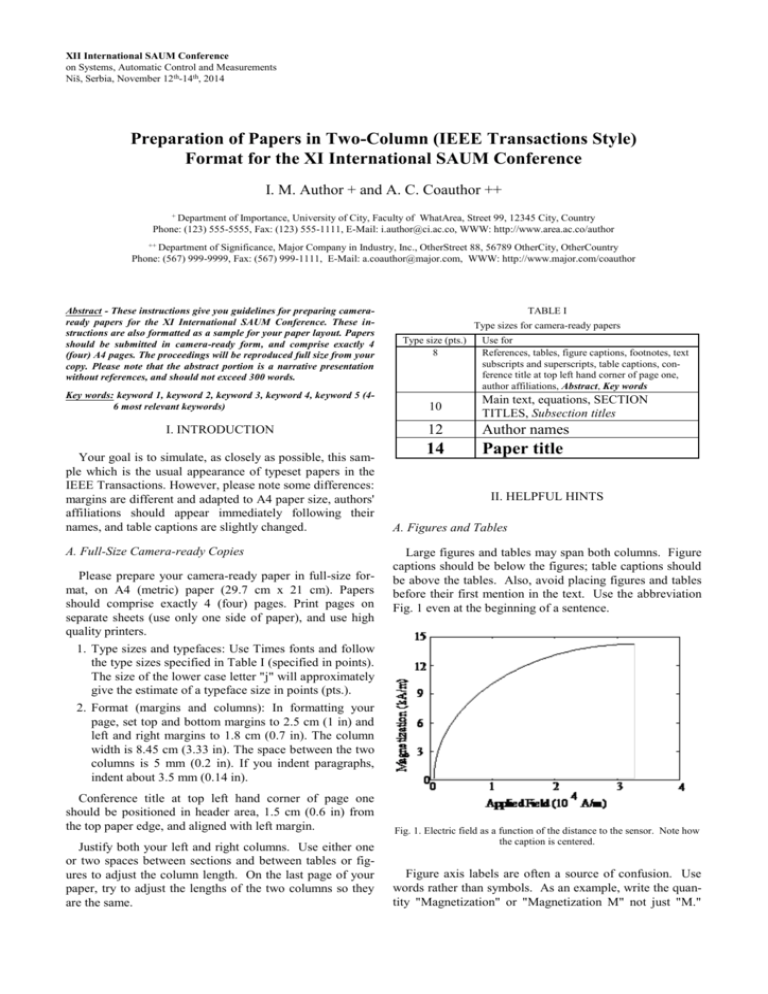
XII International SAUM Conference on Systems, Automatic Control and Measurements Niš, Serbia, November 12th-14th, 2014 Preparation of Papers in Two-Column (IEEE Transactions Style) Format for the XI International SAUM Conference I. M. Author + and A. C. Coauthor ++ + Department of Importance, University of City, Faculty of WhatArea, Street 99, 12345 City, Country Phone: (123) 555-5555, Fax: (123) 555-1111, E-Mail: i.author@ci.ac.co, WWW: http://www.area.ac.co/author ++ Department of Significance, Major Company in Industry, Inc., OtherStreet 88, 56789 OtherCity, OtherCountry Phone: (567) 999-9999, Fax: (567) 999-1111, E-Mail: a.coauthor@major.com, WWW: http://www.major.com/coauthor TABLE I Abstract - These instructions give you guidelines for preparing cameraready papers for the XI International SAUM Conference. These instructions are also formatted as a sample for your paper layout. Papers should be submitted in camera-ready form, and comprise exactly 4 (four) A4 pages. The proceedings will be reproduced full size from your copy. Please note that the abstract portion is a narrative presentation without references, and should not exceed 300 words. Type size (pts.) 8 Key words: keyword 1, keyword 2, keyword 3, keyword 4, keyword 5 (46 most relevant keywords) 10 Main text, equations, SECTION TITLES, Subsection titles I. INTRODUCTION 12 Author names 14 Paper title Your goal is to simulate, as closely as possible, this sample which is the usual appearance of typeset papers in the IEEE Transactions. However, please note some differences: margins are different and adapted to A4 paper size, authors' affiliations should appear immediately following their names, and table captions are slightly changed. A. Full-Size Camera-ready Copies Please prepare your camera-ready paper in full-size format, on A4 (metric) paper (29.7 cm x 21 cm). Papers should comprise exactly 4 (four) pages. Print pages on separate sheets (use only one side of paper), and use high quality printers. 1. Type sizes and typefaces: Use Times fonts and follow the type sizes specified in Table I (specified in points). The size of the lower case letter "j" will approximately give the estimate of a typeface size in points (pts.). 2. Format (margins and columns): In formatting your page, set top and bottom margins to 2.5 cm (1 in) and left and right margins to 1.8 cm (0.7 in). The column width is 8.45 cm (3.33 in). The space between the two columns is 5 mm (0.2 in). If you indent paragraphs, indent about 3.5 mm (0.14 in). Conference title at top left hand corner of page one should be positioned in header area, 1.5 cm (0.6 in) from the top paper edge, and aligned with left margin. Justify both your left and right columns. Use either one or two spaces between sections and between tables or figures to adjust the column length. On the last page of your paper, try to adjust the lengths of the two columns so they are the same. Type sizes for camera-ready papers Use for References, tables, figure captions, footnotes, text subscripts and superscripts, table captions, conference title at top left hand corner of page one, author affiliations, Abstract, Key words II. HELPFUL HINTS A. Figures and Tables Large figures and tables may span both columns. Figure captions should be below the figures; table captions should be above the tables. Also, avoid placing figures and tables before their first mention in the text. Use the abbreviation Fig. 1 even at the beginning of a sentence. Fig. 1. Electric field as a function of the distance to the sensor. Note how the caption is centered. Figure axis labels are often a source of confusion. Use words rather than symbols. As an example, write the quantity "Magnetization" or "Magnetization M" not just "M." Put units in parentheses. For example, write "Magnetization (A/m)" or "Magnetization (Am-1)" not A/m. Use "(1)," not "Eq. (1)" or "equation (1)," except at the beginning of a sentence: "Equation (1) is ..." Multipliers can be especially confusing. Write "Magnetization (kA/m)" or "Magnetization (103 A/m). Do not write "Magnetization (A/m) x 1000" because the reader will not know whether the top axis label in Fig. 1 means 15,000 A/m or 0.015 A/m. Figure labels should be legible, about 8-point type. D. Other Recommendations B. References Number citations consecutively in square brackets [1]. The sentence punctuation follows the brackets [2]. Refer simply to the reference number, as in [3]. Do not use "Ref. [3]" or "reference [3]" except at the beginning of a sentence: "Reference [3] was the first ..." Number footnotes separately in superscripts.1 Place the actual footnote at the bottom of the column in which it is cited. Do not put footnotes in the reference list. IEEE Transactions no longer use a journal prefix before the volume number. For example, use "IEEE Trans. IM, vol. 25," not "vol. IM-25." Note that IEEE referencing style is quite different from that used by most physics journals. Try to give all authors' names; do not use "et al" unless there are six authors or more. Papers that have not been published, even if they have been submitted for publication, should be cited as "unpublished" [4]. Papers that have been accepted for publication should be cited as "in press" [5]. C. Equations Number equations consecutively with equation numbers in parentheses flush with the right margin, as in (1). To make your equations more compact, you may use the solidus (/), the exp function, or appropriate exponents. Italicize Roman symbols for quantities and variables. Use a long dash (em) rather than a hyphen for a minus sign. Use parentheses to avoid ambiguities in denominators. Punctuate equations with commas or periods when they are part of a sentence. c (, ) 0 B p Q p (cosh ) Pp (cos ) (1) p 0 Be sure that the symbols in your equation have been defined before the equation appears or immediately following. 1 Avoid footnotes if possible. Try to integrate them into the text. Roman numerals are used to number the section headings. If you do use them, number INTRODUCTION, but not ACKNOWLEDGMENT and REFERENCES, and begin Subheadings with letters. Use two spaces after periods (full stops). Hyphenate complex modifiers: "zero-fieldcooled magnetization." III. UNITS Use the International System of Units (SI) (MS); English units may be used as secondary units (in parentheses). An exception is when English units are used as identifiers in trade, such as "3 1/2-inch disk drive." ACKNOWLEDGMENT Write acknowledgments here, such as "This paper is part of the project 'Name of the project' at the University of City, Faculty of WhatArea, and was supported by SupportingInstitution". Try to avoid the stilted expression, "One of us (R.B.G.) thanks ..." Instead, try "R.B.G. thanks ..." REFERENCES [1] G. Eason, B. Noble and I. N. Sneddon, "On certain integrals of Lipschitz-Hankel type involving products of Bessel functions", Phil. Trans. Roy. Soc. London, vol. A247, pp. 529-551, April 1955. [2] J. C. Maxwell, A Treatise on Electricity and Magnetism, 3rd ed., vol. 2. Oxford: Clarendon, 1892, pp. 68-73. [3] L. S. Jacobs and C. P. Bean, "Fine particles, thin films and exchange anisotrophy", in Magnetism, vol. III, G.T. Rado and H. Suhl, Eds. New York: Academic, 1963, pp 271-350. [4] K. Elissa, "Title of paper if known", unpublished. [5] R. Nicole, "Title of paper with only first word capitalized", J. Name Stand. Abbrev., in press. [6] Y. Yorozu, M. Hirano, K. Oka and Y. Tagawa, "Electronic spectroscopy studies on megneto-optical media and plastic substrate interface", IEEE Transl. J. Magn. Japan, vol. 2, pp.740-741, August 1987 (Digests 9th Annual Conf. Magnetics Japan, p. 301, 1982). [7] M. Young, The Technical Writer's Handbook, Mill Valley, CA: University Science, 1989. [8] W. A. Sabin, The Gregg Reference Manual, 6th ed., Gregg Division, McGraw-Hill, New York, 1985. [9] J. A. Taritz, Technical Editing. The Practical Guide for Editors and Writers, Addison-Wesley, Reading, MA, 1992. [10] The University of Chicago Press, The Chicago Manual of Style, 13th ed. Univ. of Chicago Press, 1982. [11] E. R. Tufte, The Visual Display of Quantitative Information, Graphics Press, Cheshire, Connecticut, 1983.
